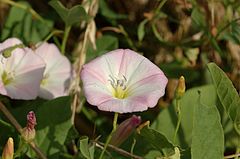Convolvulus
| Convolvulus {{{latin_name}}}
|
'
| ||||||||||||||||||||||||||||||||||||||||
|---|---|---|---|---|---|---|---|---|---|---|---|---|---|---|---|---|---|---|---|---|---|---|---|---|---|---|---|---|---|---|---|---|---|---|---|---|---|---|---|---|---|

|
|
| |||||||||||||||||||||||||||||||||||||||
| |||||||||||||||||||||||||||||||||||||||||
| Standard Cyclopedia of Horticulture |
|---|
|
Convolvulus (Latin, convolve, to entwine). Convolvulaceae. Includes Calystegia. Bindweed. Annual and perennial herbs, grown mostly in the open; some are twiners. Sometimes suffrutescent, twining, trailing, erect or ascending, with filiform, creeping rootstocks: Lvs. petiolate, entire, toothed or lobed, generally cordate or sagittate: fls. axillary, solitary or loosely cymose, mostly opening only in early morning; corolla cam panulate or funnelform, the limb plaited, 5-angled, 5-lobed or entire.—A genus of about 175 species, widely distributed in temperate and tropical regions. Convolvulus and Calystegia are no longer kept separate. As Convolvulus Sepium is the type of both genera, they are therefore synonymous. When the fls. of C. occidentalis are borne singly, the calyx bracts are broad and Calystegia-like; when borne in clusters the bracts are greatly reduced. The species thrive in a variety of soils without especial care. The greenhouse species do best in a soil with considerable fiber. The hardy perennials are usually propagated by dividing the roots, otherwise by cuttings or seeds, the tender species preferably by cuttings. C. tricolor is the most important of the hardy annuals. It may also be started in the greenhouse, and makes an excellent plant for the hanging-basket. All are vigorous growers, and may become troublesome weeds in some places if not kept within bounds. C japonicus and C. Sepium should be used with caution. This is the chief reason why the hardy perennials are not often found in well-kept gardens, except along wire fences or lattice screens, where the turf is laid up close so as to allow only a narrow border for the roots. The double-flowered form of C. japonicus is seen to best advantage in half-wild places, or on rocky banks, where shrubs make but a stunted growth. Here it will grow luxuriantly, forming graceful festoons from branch to branch, and covering the ground with a pretty mantle of green. (J. B. Keller.) C. purpureus, the common morning-glory, and many related species are to be found under Ipomoea. CH
|
Cultivation
- Do you have cultivation info on this plant? Edit this section!
Propagation
- Do you have propagation info on this plant? Edit this section!
Pests and diseases
- Do you have pest and disease info on this plant? Edit this section!
Species
Selected specieswp
- Convolvulus althaeoides – Mallow Bindweed, Riviera Bindweed
- Convolvulus angustissimus
- Convolvulus arvensis – Lesser Bindweed, Field bindweed
- Convolvulus assyricus
- Convolvulus boissieri
- Convolvulus calvertii
- Convolvulus calycina
- Convulvulus canariensis
- Convolvulus cantabricus
- Convolvulus capensis
- Convolvulus cataonnicus
- Convolvulus chilensis
- Convolvulus cneorum – Shrubby Bindweed, Silvery Bindweed, Silverbush
- Convolvulus compactus
- Convolvulus dorycnium
- Convolvulus equitans – Gray Bindweed, Texas Bindweed
- Convolvulus erubescens
- Convolvulus eyreanus
- Convolvulus floridus
- Convolvulus fractosaxosa
- Convolvulus graminetinus
- Convolvulus hermanniae
- Convolvulus holosericeus
- Convolvulus humilis
- Convolvulus incanus
- Convolvulus lineatus – Pygmy Bindweed
- Convolvulus nodiflorus – Aguinaldo Blanco
- Convolvulus ocellatus
- Convolvulus oleifolius
- Convolvulus pentapetaloides
- Convolvulus persicus
- Convolvulus phrygius
- Convolvulus pilosellifolius – Soft Bindweed
- Convolvulus remotus
- Convolvulus sabatius – Blue Rock Bindweed
- Convolvulus scammonia – Scammony
- Convolvulus secundus - [1]
- Convolvulus scoparius
- Convolvulus siculus
- Convolvulus suffruticosus
- Convolvulus tricolor – Dwarf Convolvulus, Dwarf Morning Glory
- Convolvulus verecundus
- Convolvulus waitaha
- Convolvulus wallichianus – Wallich's Bindweed
C. althaeoides. Linn. (C. italicus, Roem. & Schult.). St. prostrate, twining or climbing, if it finds support: upper lvs. pedatifid.; lower ovate-cordate, crenate, silvery: fls. pink. May-Aug. Medit. region. B.M. 359. F.S. 10:1021 (as var. argyreus). CH
- C. ambigens, House, native from Mont, to New Mex. and S. Calif., is a close relative to C. arvensis.CH
- C. arvensis. Linn. Slender perennial trailer, 1-3 ft. long, glabrous or nearly so: lvs. ovate-sagittate or hastate, variable: fls. white or pink. Eu. and E. Asia. Naturalized in old fields through the Atlantic states and Calif. A troublesome weed in cult, grounds.CH
- C. canariensis. Linn. Greenhouse evergreen: lvs. oblong-cordate, acute, villose: fls. violet-purple; peduncle 1-6-fld. Canary Isls.CH
- C. dahuricus Herb. (Calystegia dahuricus, Fisch.). Hardy deciduous twiner, 3-6 ft.: lvs. oblong-cordate, shortly acute: fls. pink or rose-violet. June, July. N. Eu. B.M. 2609. F.S. 10:1075.CH
- C. erubescens, Sims (C. acaulis, Choisy). Tender biennial: lvs. oblong, hastate, the basal lobes toothed: fls. small, 6-lobed. row-pink. Austral. B.M. 1067. CH
- C. macrostegius, Greene. The plants in the trade under this name may be referred to C. occidentalis.CH
- C. major, Hort., not Gilib.= Ipomoea purpurea.CH
- C. ocellatus, Hook. Stove evergreen: limb of corolla white, 5-angled; throat reddish purple: lvs. sessile, linear, acute, 1-veined, villose. S. Afr.CH
- C. scoparius, Linn.CH
- C. Soldanella, Linn. Sts. prostrate: lvs. reniform: fls. pink or rose colored. Sandy shores, Wash, to Calif.; also in Eu. and Asia.CH
Gallery
If you have a photo of this plant, please upload it! Plus, there may be other photos available for you to add.
References
- Standard Cyclopedia of Horticulture, by L. H. Bailey, MacMillan Co., 1963
External links
- w:Convolvulus. Some of the material on this page may be from Wikipedia, under the Creative Commons license.
- Convolvulus QR Code (Size 50, 100, 200, 500)



